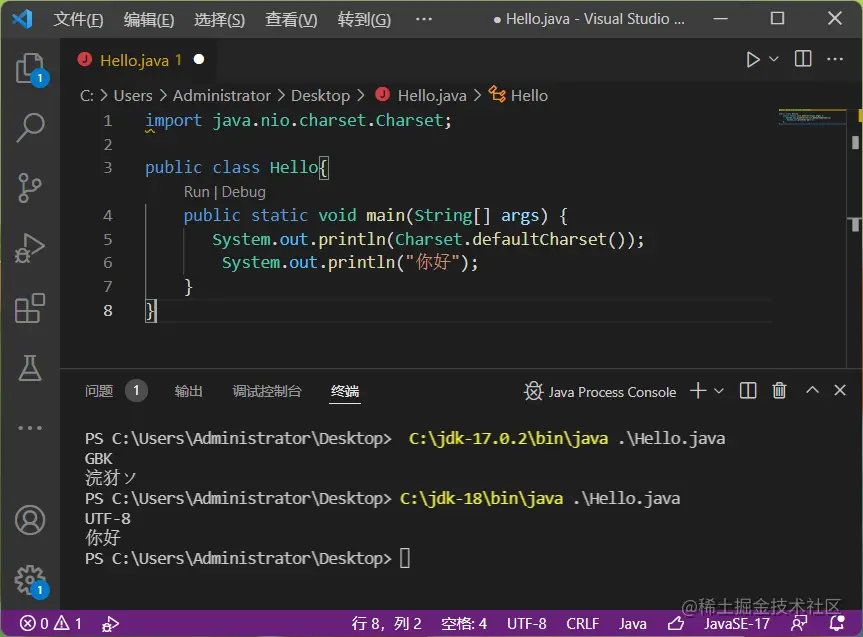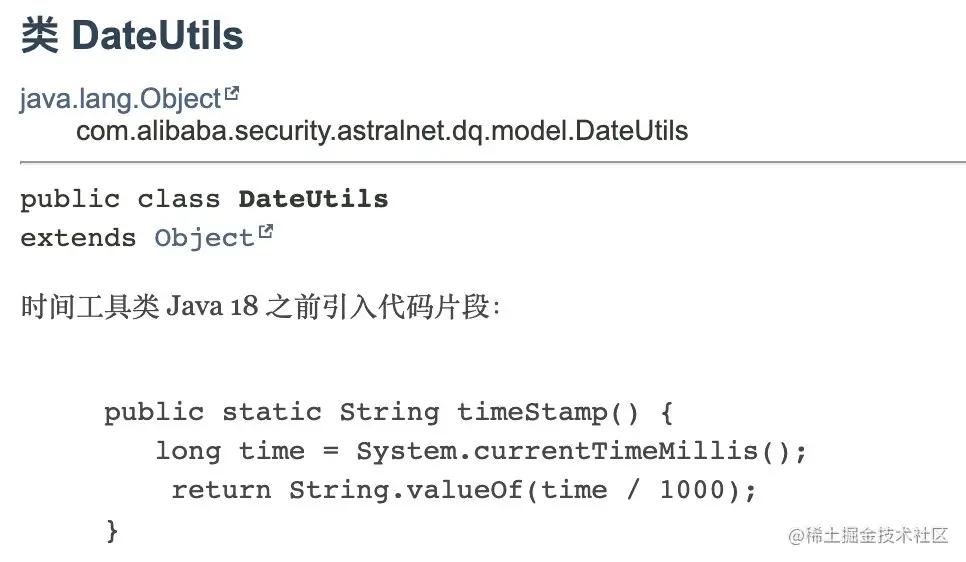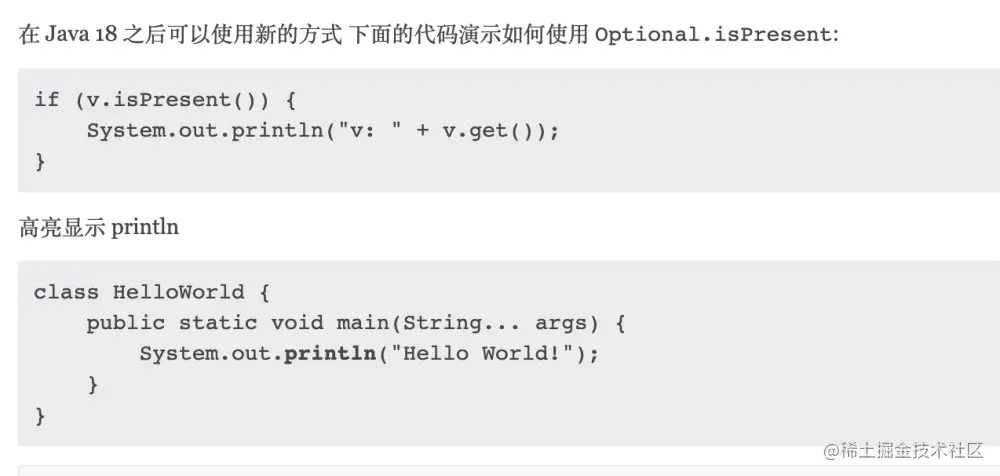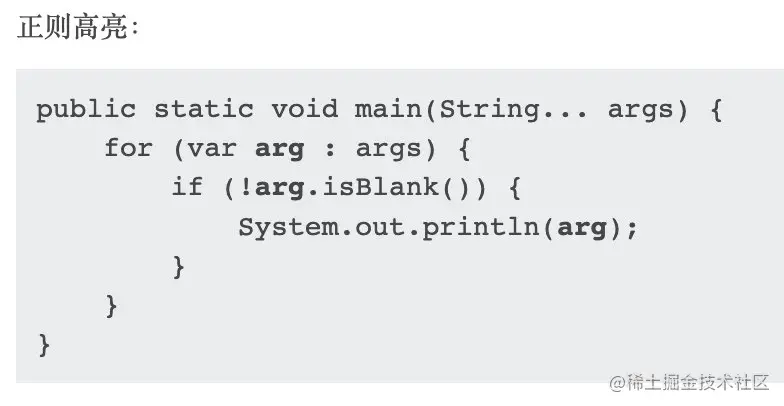文章持续更新,可以关注公众号程序猿阿朗或访问未读代码博客。
本文 Github.com/niumoo/JavaNotes 已经收录,欢迎Star。
Java 18 在2022 年 3 月 22 日正式发布,Java 18 不是一个长期支持版本,这次更新共带来 9 个新功能。
OpenJDK Java 18 下载:https://jdk.java.net/18/
OpenJDK Java 18 文档:https://openjdk.java.net/projects/jdk/18/
JDK 一直都是支持 UTF-8 字符编码,这次是把 UTF-8 设置为了默认编码,也就是在不加任何指定的情况下,默认所有需要用到编码的 JDK API 都使用 UTF-8 编码,这样就可以避免因为不同系统,不同地区,不同环境之间产生的编码问题。
Mac OS 默认使用 UTF-8 作为默认编码,但是其他操作系统上,编码可能取决于系统的配置或者所在区域的设置。如中国大陆的 windows 使用 GBK 作为默认编码。很多同学初学 Java 时可能都遇到过一个正常编写 Java 类,在 windows 系统的命令控制台中运行却出现乱码的情况。
使用下面的命令可以输出 JDK 的当前编码。
# Mac 系统,默认 UTF-8
➜ ~ java -XshowSettings:properties -version 2>&1 | grep file.encoding
file.encoding = UTF-8
file.encoding.pkg = sun.io
➜ ~
下面编写一个简单的 Java 程序,输出默认字符编码,然后输出中文汉字 ”你好“,看看 Java 18 和 Java 17 运行区别。
系统环境:Windows 11
import java.nio.charset.Charset;
public class Hello{
public static void main(String[] args) {
System.out.println(Charset.defaultCharset()); System.out.println("你好"); }
}从下面的运行结果中可以看到,使用 JDK 17 运行输出的默认字符编码是 GBK,输出的中文 ”你好“ 已经乱码了;乱码是因为 VsCode 默认的文本编辑器编码是 UTF-8,而中国地区的 Windows 11 默认字符编码是 GBK,也是 JDK 17 默认获取到的编码,所以会在控制台输出时乱码;而使用 JDK 18 输出的默认编码就是 UTF-8,所以可以正常的输出中文 ”你好“。

在 Java 18 中,提供了一个新命令 jwebserver,运行这个命令可以启动一个简单的 、最小化的静态Web 服务器,它不支持 CGI 和 Servlet,所以最好的使用场景是用来测试、教育、演示等需求。
其实在如 Python、Ruby、PHP、Erlang 等许多平台都提供了开箱即用的 Web 服务器,可见一个简单的Web 服务器是一个常见的需求,Java 一直没有这方面的支持,现在可以了。
在 Java 18 中,使用 jwebserver 启动一个 Web 服务器,默认发布的是当前目录。
在当前目录创建一个网页文件 index.html
<html>
<head>
<meta http-equiv="Content-Type" content="text/html; charset=utf-8" />
</head>
<body>
<h1>标题</h1>
</body>
</html>
启动 jwebserver.
➜ bin ./jwebserver
Binding to loopback by default. For all interfaces use "-b 0.0.0.0" or "-b ::".
Serving /Users/darcy/develop/jdk-18.jdk/Contents/Home/bin and subdirectories on 127.0.0.1 port 8000
URL http://127.0.0.1:8000/
浏览器访问:

有请求时会在控制台输出请求信息:
127.0.0.1 - - [26/3月/2022:16:53:30 +0800] "GET /favicon.ico HTTP/1.1" 404 -
127.0.0.1 - - [26/3月/2022:16:55:13 +0800] "GET / HTTP/1.1" 200 -
通过 help 参数可以查看 jwebserver 支持的参数。
➜ bin ./jwebserver --help
Usage: jwebserver [-b bind address] [-p port] [-d directory]
[-o none|info|verbose] [-h to show options]
[-version to show version information]
Options:
-b, --bind-address - 绑定地址. Default: 127.0.0.1 (loopback).
For all interfaces use "-b 0.0.0.0" or "-b ::".
-d, --directory - 指定目录. Default: current directory.
-o, --output - Output format. none|info|verbose. Default: info.
-p, --port - 绑定端口. Default: 8000.
-h, -?, --help - Prints this help message and exits.
-version, --version - Prints version information and exits.
To stop the server, press Ctrl + C.
在 Java 18 之前,已经支持在 Javadoc 中引入代码片段,这样可以在某些场景下更好的展示描述信息,但是之前的支持功能有限,比如我想高亮代码片段中的某一段代码是无能为力的。现在 Java 18 优化了这个问题,增加了 @snippet 来引入更高级的代码片段。
在 Java 18 之前,使用 <pre>{@code ...}</pre> 来引入代码片段。
/**
* 时间工具类
* Java 18 之前引入代码片段:
* <pre>{@code
* public static String timeStamp() {
* long time = System.currentTimeMillis();
* return String.valueOf(time / 1000);
* }
* }</pre>
*
*/
生成 Javadoc 之后,效果如下:

从 Java 18 开始,可以使用 @snippet 来生成注释,且可以高亮某个代码片段。
/**
* 在 Java 18 之后可以使用新的方式
* 下面的代码演示如何使用 {@code Optional.isPresent}:
* {@snippet :
* if (v.isPresent()) {
* System.out.println("v: " + v.get());
* }
* }
*
* 高亮显示 println
*
* {@snippet :
* class HelloWorld {
* public static void main(String... args) {
* System.out.println("Hello World!"); // @highlight substring="println"
* }
* }
* }
*
*/
效果如下,更直观,效果更好。

甚至可以使用正则来高亮某一段中的某些关键词:
/**
* 正则高亮:
* {@snippet :
* public static void main(String... args) {
* for (var arg : args) { // @highlight region regex = "\barg\b"
* if (!arg.isBlank()) {
* System.out.println(arg);
* }
* } // @end
* }
* }
*/
生成的 Javadoc 效果如下:

可以使用正则表达式来替换某一段代码。
/**
* 正则替换:
* {@snippet :
* class HelloWorld {
* public static void main(String... args) {
* System.out.println("Hello World!"); // @replace regex='".*"' replacement="..."
* }
* }
* }
*/
这段注释会生成如下 Javadoc 效果。
class HelloWorld {
public static void main(String... args) {
System.out.println(...);
}
}
# 使用 javadoc 命令生成 Javadoc 文档
➜ bin ./javadoc -public -sourcepath ./src -subpackages com -encoding utf-8 -charset utf-8 -d ./javadocout
# 使用 Java 18 的 jwebserver 把生成的 Javadoc 发布测试
➜ bin ./jwebserver -d /Users/darcy/develop/javadocout
访问测试:

Java 18 改进了 java.lang.reflect.Method、Constructor 的实现逻辑,使之性能更好,速度更快。这项改动不会改动相关 API ,这意味着开发中不需要改动反射相关代码,就可以体验到性能更好反射。
OpenJDK 官方给出了新老实现的反射性能基准测试结果。
Java 18 之前:
Benchmark Mode Cnt Score Error Units
ReflectionSpeedBenchmark.constructorConst avgt 10 68.049 ± 0.872 ns/opReflectionSpeedBenchmark.constructorPoly avgt 10 94.132 ± 1.805 ns/op
ReflectionSpeedBenchmark.constructorVar avgt 10 64.543 ± 0.799 ns/op
ReflectionSpeedBenchmark.instanceFieldConst avgt 10 35.361 ± 0.492 ns/opReflectionSpeedBenchmark.instanceFieldPoly avgt 10 67.089 ± 3.288 ns/op
ReflectionSpeedBenchmark.instanceFieldVar avgt 10 35.745 ± 0.554 ns/op
ReflectionSpeedBenchmark.instanceMethodConst avgt 10 77.925 ± 2.026 ns/op
ReflectionSpeedBenchmark.instanceMethodPoly avgt 10 96.094 ± 2.269 ns/op
ReflectionSpeedBenchmark.instanceMethodVar avgt 10 80.002 ± 4.267 ns/op
ReflectionSpeedBenchmark.staticFieldConst avgt 10 33.442 ± 2.659 ns/op
ReflectionSpeedBenchmark.staticFieldPoly avgt 10 51.918 ± 1.522 ns/op
ReflectionSpeedBenchmark.staticFieldVar avgt 10 33.967 ± 0.451 ns/op
ReflectionSpeedBenchmark.staticMethodConst avgt 10 75.380 ± 1.660 ns/op
ReflectionSpeedBenchmark.staticMethodPoly avgt 10 93.553 ± 1.037 ns/op
ReflectionSpeedBenchmark.staticMethodVar avgt 10 76.728 ± 1.614 ns/opJava 18 的新实现:
Benchmark Mode Cnt Score Error Units
ReflectionSpeedBenchmark.constructorConst avgt 10 32.392 ± 0.473 ns/opReflectionSpeedBenchmark.constructorPoly avgt 10 113.947 ± 1.205 ns/op
ReflectionSpeedBenchmark.constructorVar avgt 10 76.885 ± 1.128 ns/op
ReflectionSpeedBenchmark.instanceFieldConst avgt 10 18.569 ± 0.161 ns/opReflectionSpeedBenchmark.instanceFieldPoly avgt 10 98.671 ± 2.015 ns/op
ReflectionSpeedBenchmark.instanceFieldVar avgt 10 54.193 ± 3.510 ns/op
ReflectionSpeedBenchmark.instanceMethodConst avgt 10 33.421 ± 0.406 ns/op
ReflectionSpeedBenchmark.instanceMethodPoly avgt 10 109.129 ± 1.959 ns/op
ReflectionSpeedBenchmark.instanceMethodVar avgt 10 90.420 ± 2.187 ns/op
ReflectionSpeedBenchmark.staticFieldConst avgt 10 19.080 ± 0.179 ns/op
ReflectionSpeedBenchmark.staticFieldPoly avgt 10 92.130 ± 2.729 ns/op
ReflectionSpeedBenchmark.staticFieldVar avgt 10 53.899 ± 1.051 ns/op
ReflectionSpeedBenchmark.staticMethodConst avgt 10 35.907 ± 0.456 ns/op
ReflectionSpeedBenchmark.staticMethodPoly avgt 10 102.895 ± 1.604 ns/op
ReflectionSpeedBenchmark.staticMethodVar avgt 10 82.123 ± 0.629 ns/op可以看到在某些场景下性能稍微好些。
JEP 417:Vector API(三次孵化)在 Java 16 中引入一个新的 API 来进行向量计算,它可以在运行时可靠的编译为支持的 CPU 架构,从而实现更优的计算能力。
在 Java 17 中改进了 Vector API 性能,增强了例如对字符的操作、字节向量与布尔数组之间的相互转换等功能。
现在在 JDK 18 中将继续优化其性能。
JEP 418:互联网地址解析 SPI对于互联网地址解析 SPI,为主机地址和域名地址解析定义一个 SPI,以便java.net.InetAddress可以使用平台内置解析器以外的解析器。
InetAddress inetAddress = InetAddress.getByName("www.wdbyte.com");
System.out.println(inetAddress.getHostAddress());
// 输出
// 106.14.229.49
新的 API 允许 Java 开发者与 JVM 之外的代码和数据进行交互,通过调用外部函数,可以在不使用 JNI 的情况下调用本地库。
这是一个孵化功能;需要添加--add-modules jdk.incubator.foreign来编译和运行 Java 代码,Java 18 改进了相关 API ,使之更加简单易用。
历史
- Java 14 JEP 370 (opens new window)引入了外部内存访问 API(孵化器)。
- Java 15 JEP 383 (opens new window)引入了外部内存访问 API(第二孵化器)。
- Java 16 JEP 389 (opens new window)引入了外部链接器 API(孵化器)。
- Java 16 JEP 393 (opens new window)引入了外部内存访问 API(第三孵化器)。
- Java 17 JEP 412 (opens new window)引入了外部函数和内存 API(孵化器)。
从 Java 17 开始,对于 Switch 的改进就已经在进行了,Java 17 的 JEP 406 已经对 Switch 表达式进行了增强,使之可以减少代码量。
下面是几个例子:
// JDK 17 以前
static String formatter(Object o) {
String formatted = "unknown";
if (o instanceof Integer i) {
formatted = String.format("int %d", i);
} else if (o instanceof Long l) {
formatted = String.format("long %d", l);
} else if (o instanceof Double d) {
formatted = String.format("double %f", d);
} else if (o instanceof String s) {
formatted = String.format("String %s", s);
}
return formatted;
}
而在 Java 17 之后,可以通过下面的写法进行改进:
// JDK 17 之后
static String formatterPatternSwitch(Object o) {
return switch (o) {
case Integer i -> String.format("int %d", i);
case Long l -> String.format("long %d", l);
case Double d -> String.format("double %f", d);
case String s -> String.format("String %s", s);
default -> o.toString();
};
}
switch 可以和 null 进行结合判断:
static void testFooBar(String s) {
switch (s) {
case null -> System.out.println("Oops"); case "Foo", "Bar" -> System.out.println("Great");
default -> System.out.println("Ok");
}
}case 时可以加入复杂表达式:
static void testTriangle(Shape s) {
switch (s) {
case Triangle t && (t.calculateArea() > 100) -> System.out.println("Large triangle");
default ->
System.out.println("A shape, possibly a small triangle");
}
}case 时可以进行类型判断:
sealed interface S permits A, B, C {}
final class A implements S {}
final class B implements S {}
record C(int i) implements S {} // Implicitly final
static int testSealedExhaustive(S s) {
return switch (s) {
case A a -> 1;
case B b -> 2;
case C c -> 3;
};
}
扩展:JEP 406:Switch 的类型匹配(预览)
JEP 421:弃用删除相关在未来将删除 Finalization,目前 Finalization 仍默认保持启用状态,但是已经可以手动禁用;在未来的版本中,将会默认禁用;在以后的版本中,它将被删除。需要进行资源管理可以尝试 try-with-resources 或者 java.lang.ref.Cleaner。
- JDK 18 Features(https://openjdk.java.net/projects/jdk/18/)
可以微信搜一搜程序猿阿朗或访问未读代码博客阅读。
本文 Github.com/niumoo/JavaNotes 已经收录,欢迎Star。
